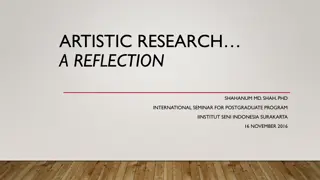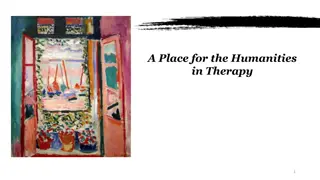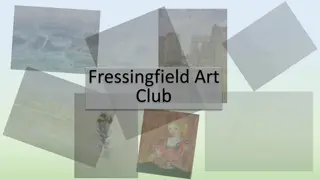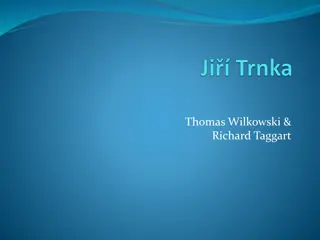Exploring the Artistic Legacy of Bill Reid
Renowned artist Bill Reid, known for his iconic Haida creations, left a lasting impact through his sculptures, carvings, and contributions to indigenous art. With a focus on Haida culture and storytelling, his work showcases intricate details and deep cultural narratives. From the Raven and the First Men to the Killer Whale brooch, Reid's artistry reflects his connection to his heritage. Explore his journey from goldsmithing classes to large-scale sculptures like the Spirit of Haida Gwaii, immersing in the richness of his artistic contributions to Canadian and indigenous art.
Download Presentation

Please find below an Image/Link to download the presentation.
The content on the website is provided AS IS for your information and personal use only. It may not be sold, licensed, or shared on other websites without obtaining consent from the author. Download presentation by click this link. If you encounter any issues during the download, it is possible that the publisher has removed the file from their server.
E N D
Presentation Transcript
Bill Reid, The Raven and the First Men, 1980. One of Reid s most iconic large-scale works depicts a Haida creation story.
Bill Reid, Killer Whale Brooch, c.1952-53. The Killer Whale appears in much of Reid s work, as in this delicately carved sterling silver brooch.
Bill Reid watching memorial pole being raised in the Haida Village at Totem Park at the University of British Columbia, 1962.
Loo Taas being paddled at the opening of the Haida Heritage Centre at Kay LInagaay, 2007.
Bill Reid at the CBC, 1950. Reid began taking goldsmithing classes while working as an announcer for the CBC.
A view of the Indians of Canada Pavilion at Expo 67, 1967. The murals were painted by Francis Kagige. The Kwakiutl totem pole was carved by Tony and Henry Hunt.
Bill Reid seated beside The Raven and the First Men at the UBC Museum of Anthropology, Vancouver, c. 1980.
Bill Reid, Spirit of Haida Gwaii, 1986. This is the most complex and best known of Bill Reid s sculptures.
Learning Activity #1 Iljuwas Bill Reid with his tools in Skidegate, 1976.
Learning Activity #1 Daxhiigang (Charles Edenshaw) with his works in Masset, British Columbia, c. 1890.
Learning Activity #1 Daxhiigang (Charles Edenshaw), Bracelet, 1909. Bracelets have significance in Haida culture as worn, visual indicators of oral knowledge and family lineages.
Learning Activity #1 Bill Reid, Bracelet, 1955. Reid regarded bracelets as integral to his practice and study of Haida forms.
Learning Activity #1 Daxhiigang (Charles Edenshaw), Bracelet, c. 1885. Reid was captivated by Haida design after encountering gold bracelets by Daxhiigang.
Learning Activity #1 Bill Reid, Hinged Raven Bracelet, c. 1955. This bracelet depicts the Raven (Xhuuya), a cultural hero and trickster in Haida stories.
Learning Activity #1 Bill Reid carving a clay model of the sculpture Spirit of Haida Gwaii in 1986.
Learning Activity #1 Bill Reid, Dogfish Brooch, c. 1959. The dogfish is a common symbol in Haida culture.
Learning Activity #1 Bill Reid, Tschumos Brooch, 1956. This brooch belonged to Bill Reid s mother, Sophie Reid (n e Gladstone).
Learning Activity #2 Bill Reid holding Killer Whale (1982), c. 1982. The tiny boxwood sculpture pictured here inspired Reid s monumental bronze Skaana Killer Whale, Chief of the Undersea World.
Learning Activity #2 Bill Reid carving the Skidegate Dogfish Pole, c. 1976.
Learning Activity #2 Bill Reid, Haida Village (1958-62), 1966. Haida Village was installed at the University of British Columbia in Vancouver and stands today as a showcase of Haida-style poles.
Learning Activity #2 Bill Reid, Self-portrait illustration, 1965, from Raven s Cry (1965) by Christie Harris.
Learning Activity #2 Cover of Raven s Cry, 1965, by Christie Harris. Raven s Cry is a fictionalized account of Haida history that includes a character based on Reid.
Culminating Task Haida Gwaii community members carrying the Skidegate Dogfish Pole, 1978.
Culminating Task Skidegate Dogfish Pole raising ceremony in Skidegate, Haida Gwaii, 1978. The raising ceremony was a community endeavor involving a two-day potlatch and the production of new regalia.
Culminating Task Skidegate Dogfish Pole raising ceremony in Skidegate, Haida Gwaii, 1978.
Culminating Task Skidegate Dogfish Pole raising ceremony in Skidegate, Haida Gwaii, 1978.
Culminating Task Rooftop cheer after Skidegate Dogfish Pole raising (left to right: Ernie Wilson, Phil Gladstone and Wes Pearson), 1978.
Culminating Task Skidegate longhouse designed by Rudy Kovach (left) with totem pole by Bill Reid (right), 1978.
Culminating Task Rudy Kovach, The Skidegate Project, 1977. In this painting, the artist envisions the Skidegate Dogfish Pole raised in situ, one year before the pole was completed.
Bill Reid, The Final Exam, 1964. Reid made this small silver box while studying collections of Haida art.
Bill Reid, Cedar Screen, 1968. This was Reid s first large-scale attempt to combine multiple mythic narratives in a rectilinear relief panel instead of a linear panel or pole.
Bill Reid, Spirit of Haida Gwaii: The Black Canoe, 1991. This work appears in the Canadian Embassy in Washington, D.C.
Bill Reid, Killer Whale Box with Beaver and Human, 1971. This container illustrates Reid s ability to both honour and transform important crests in Haida culture.
Bill Reid, Sgwaagan Sockeye Salmon Pool Sgwagaan, 1991. Reids multimedia works, like this serigraph print, reflect the dynamic energy of Haida art.

























